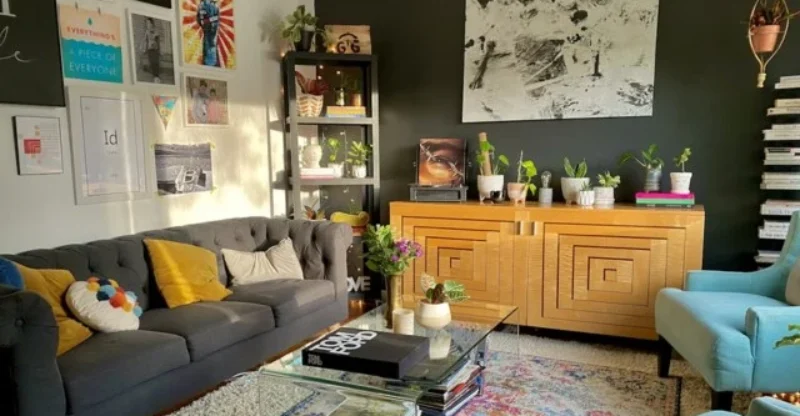10 Ways to Add Color to Living Room Saving Energy & Budget
Styles and trends are ever-evolving, and your living room can evolve with them. One of the most transformative ways to keep your living room fresh and vibrant is by adding color.
Not only does it enhance the visual appeal of your space, but it also radiates positive energy, increasing mindfulness and creating a fresh feel that both you and your guests will enjoy.
Color can set the mood, from creating a sense of pride in your well-decorated space to fostering romantic vibes for those cozy evenings.
It can even introduce a whole new cultural aesthetic to your home. This article will guide you through 10 ways to infuse color into your living room, all while saving energy and staying within your budget.
Whether you’re a fan of bold, vibrant hues or have a soft spot for subtler tones, there’s something for everyone.
1. The Power of Colorful Rugs
Colorful rugs can be a game-changer in your living room. They not only add a splash of color but also define the space and create a sense of comfort.
A vibrant rug can be the focal point of your living room, drawing attention and setting the tone for the rest of the decor.
Note: This website is supported by readers and if you click on our links we may earn a commission and as an Amazon Associate, we earn from qualifying purchases.
It’s an easy and budget-friendly way to introduce color without committing to a paint job. Whether you choose a rug with a bold pattern or a solid color, it can make a significant impact on the overall look and feel of your living room.
2. The Impact of Vibrant Throw Pillows
Throw pillows are a simple yet effective way to add a splash of color to your living room. They’re versatile, affordable, and can be easily swapped according to the season or your mood.
Vibrant throw pillows can bring a neutral sofa to life, add comfort to your seating, and tie together the different colors in your room.
When choosing throw pillows, don’t be afraid to mix and match different colors, patterns, and textures.
For instance, you could pair solid-colored pillows with patterned ones for a dynamic look. Or you could stick to a specific color palette and play around with different shades and tints.
Remember, the goal is to add visual interest to your living room, so have fun with it.
3. The Role of Plants and Flowers
Plants and flowers are a great way to add color and life to your living room. They not only improve the aesthetics of your room but also have health benefits, such as purifying the air and boosting your mood.
You can choose from a variety of houseplants with colorful leaves or flowers. For a low-maintenance option, consider succulents or cacti.
If you don’t have a green thumb, artificial plants and flowers are a great alternative. They require no upkeep and still add a touch of nature to your room.
For a more dramatic effect, consider a large indoor plant like a fiddle leaf fig or a monstera. On the other hand, small potted plants can be placed on shelves or tables.
Whichever you choose, plants and flowers are a sure way to add a burst of color to your living room.
4. Influence of Artwork
Artwork is a wonderful way to inject color and personality into your living room. It can serve as a focal point, inspire your color palette, or simply add a touch of beauty to your space.
Whether it’s a large-scale painting, a series of prints, or a gallery wall of personal photos, artwork can make a significant impact. When choosing artwork, consider pieces that resonate with you personally.
They could be works by your favorite artists, pieces that evoke certain memories, or even DIY creations.
Remember, the goal is to create a space that feels uniquely yours. If you’re on a budget, consider purchasing prints or posters of famous artworks.
They’re often more affordable than original pieces but can still add a touch of elegance to your living room. Alternatively, you can frame pages from a beautiful calendar or coffee table book.
5. Stylish Accent Furniture
Accent furniture pieces are a fantastic way to add color to your living room. These could be a vibrant armchair, a painted coffee table, or a brightly upholstered ottoman. Not only do these pieces add color, but they also serve a functional purpose.
When choosing accent furniture, consider the overall style of your living room. If your room has a modern aesthetic, look for pieces with clean lines and bold colors.
If your style is more traditional, consider furniture with ornate details and rich, warm colors. Remember, accent furniture should enhance your living room, not overpower it.
So, choose pieces that complement the other elements in your room. And don’t be afraid to mix and match different styles. Sometimes, the most unexpected combinations can create the most stunning results.
6. The Effect of Bold Curtains
Curtains are not just functional elements that provide privacy and control light; they can also be a significant decorative element in your living room.
Bold curtains can add a pop of color, create a focal point, and even make your room look larger. When choosing curtains, consider the overall color scheme and style of your living room.
If your room is mostly neutral, curtains in a bold color or pattern can add a much-needed splash of color. On the other hand, if your room already has a lot of colors, you might want to choose curtains in a neutral color to balance things out.
Remember, curtains can change the perceived size of your living room. Dark, heavy curtains can make a room feel smaller but cozier, while light, airy curtains can make a room feel larger and brighter.
7. Use of Lighting Fixtures
Lighting fixtures are another excellent way to add color to your living room. A colorful lamp or pendant light can serve as a statement piece and add a warm, inviting glow to your room.
When choosing lighting fixtures, consider the size of your room and the amount of natural light it receives.
If your room is small or doesn’t get a lot of natural light, you might want to choose a light fixture that provides plenty of illumination. If your room is large or gets a lot of natural light, you can choose a fixture that provides more ambient lighting.
8. Creativity with Coffee Table Decorations
Your coffee table is not just a place to set down your cup of coffee; it’s also a prime spot for adding a splash of color.
By creatively decorating your coffee table, you can make it a focal point of your living room. Start by choosing a few key pieces that you love.
This could be a colorful tray, a vibrant vase, or a stack of books with brightly colored spines. Then, add some smaller decorative items for variety.
These could be coasters, candles, or small figurines. Remember to vary the heights of your items to create visual interest.
Don’t forget to leave some space on your coffee table for practical items, like a remote control or a coaster for drinks. After all, your coffee table needs to be functional as well as beautiful.
9. Add Bursts of Color With Accessories
Accessories are the finishing touches that can bring a room together and make it feel complete. They can add bursts of color, introduce new textures, and reflect your personal style.
Consider adding colorful cushions, throws, vases, candles, or picture frames to your living room.
Even small items, like coasters or decorative bowls, can add a pop of color. When choosing accessories, consider the overall color scheme of your room.
If your room is mostly neutral, accessories in bold colors can add a much-needed splash of color.
On the other hand, if your room already has a lot of colors, you might want to choose accessories in neutral or complementary colors to balance things out.
10. Role of Accent Walls
An accent wall can dramatically change the look and feel of your living room. It draws the eye, adds depth and interest, and allows you to experiment with colors and patterns that you might not want to use in the entire room.
When choosing a color for your accent wall, consider the overall color scheme of your room. You could choose a color that contrasts with the other walls to create a bold statement, or a color that complements the other walls for a more subtle look.
You can also consider using wallpaper or a wall mural for your accent wall. These can add a lot of personality and visual interest to your room.
If you’re feeling adventurous, you could even try a textured wall treatment, like shiplap or beadboard. Remember, the goal of an accent wall is to enhance your room, not overpower it. So, choose a wall that naturally draws the eye, like the wall behind your sofa or TV.



